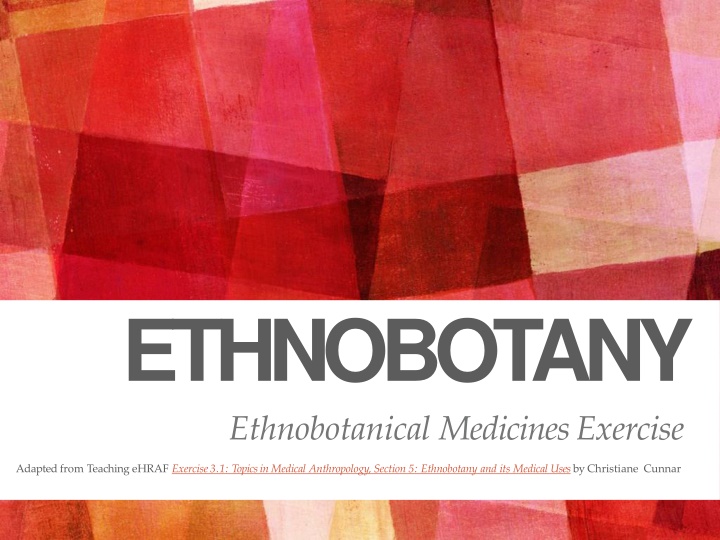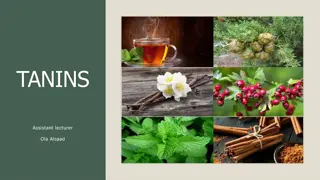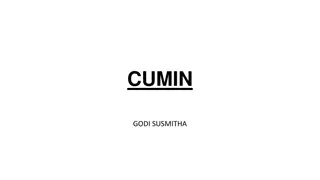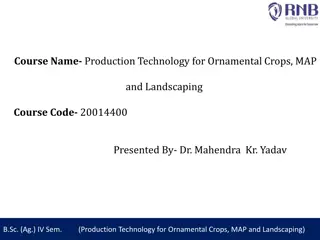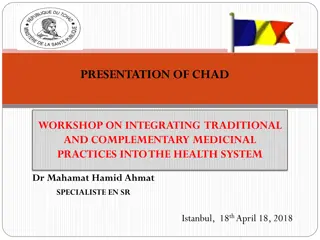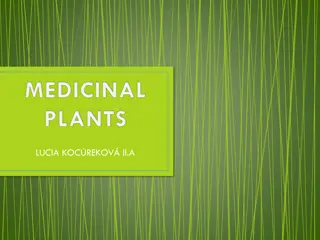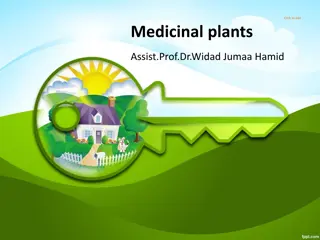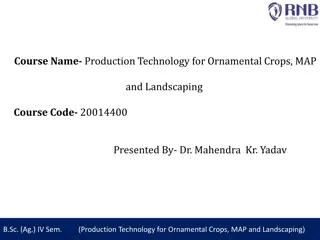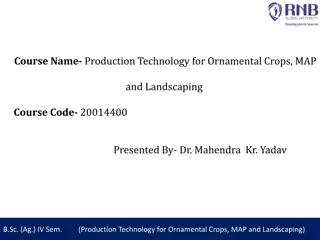Ethnobotanical Medicinal Practices in Different Cultures
Traditional medical practices in various societies utilize plants, herbs, and fruits for their healing properties. Common examples include garlic and ginger, known for their antiseptic and remedial qualities. This teaching exercise from Yale University delves into the diverse cultural perspectives on medicinal properties of natural resources and emphasizes effective search strategies in studying ethnobotany.
Download Presentation

Please find below an Image/Link to download the presentation.
The content on the website is provided AS IS for your information and personal use only. It may not be sold, licensed, or shared on other websites without obtaining consent from the author.If you encounter any issues during the download, it is possible that the publisher has removed the file from their server.
You are allowed to download the files provided on this website for personal or commercial use, subject to the condition that they are used lawfully. All files are the property of their respective owners.
The content on the website is provided AS IS for your information and personal use only. It may not be sold, licensed, or shared on other websites without obtaining consent from the author.
E N D
Presentation Transcript
ETHNOBOTANY Ethnobotanical MedicinesExercise Adapted from Teaching eHRAF Exercise 3.1: Topics in Medical Anthropology, Section 5: Ethnobotany and its Medical Usesby Christiane Cunnar
Tobacco plant botanical drawing drawn and engraved by Copland& Samsun 1789. Public DomainImage This exercise asks you to explore ethnobotanical practices across several societies. ETHNOBOTANICAL MEDICINE This Teaching Exercise is provided by the Human Relations Area Files at Yale University in New Haven, CT
EXERCISE DETAILS TIME: 30 minutes MATERIALS REQUIRED: HRAF Access Worksheet and pen or other materials for recording answers STUDENT LEARNING OUTCOMES: At the end of this assignment,youwill be able to: compare and contrast the cultural views regarding medicinal properties of common plants, herbs, and fruits. construct effective and efficient search strategies in eHRAF in order to retrieve data relevant to a specific topic/assignment. appreciate the cultural diversity of medicinal knowledge across the globe This Teaching Exercise is provided by the Human Relations Area Files at Yale University in New Haven, CT
In many traditional medical practices, plants, herbs, and fruits are used for their healing properties. Assembled herbs. Jonas Weckschmied on Flickr. Public DomainImage This Teaching Exercise is provided by the Human Relations Area Files at Yale University in New Haven, CT
For example, the antiseptic properties of garlic are known to a great number of societies. Garlic has been used to cure everything from bites, colds, boils, and furuncles, to wounds and fevers. Abasket of garlic clovesfrom the farmer s market. ByJeremy Keith from Brighton&Hove, UnitedKingdom[CC BY2.0 (http:// creativecommons.org/licenses/by/2.0)], via WikimediaCommons This Teaching Exercise is provided by the Human Relations Area Files at Yale University in New Haven, CT
This Teaching Exercise is provided by the Human Relations Area Files at Yale University in New Haven, CT Ginger is also widespread as a remedy. It is not only used for treating eye inflammations, stomach-aches, fevers and colds, but it is also used for childbirth. Ginger and its Varieties. McCormick and company [Public domain], via WikimediaCommons
Rosemary is a good general herbal medication and will cure everything from headaches to toothaches. Rosemary sketch. By Unknown artist from Italy [Public domain], via WikimediaCommons This Teaching Exercise is provided by the Human Relations Area Files at Yale University in New Haven, CT
Inthis exercise,youwill explore the medicinalusesof a specific plant, herb, or fruit across a number of societies and world regions in order to better grasp variations intraditional medicinal practices. ASSIGNMENT Selection of ApothecaryJars.WellcomeImages. UKCC4.0 via Wikimedia. This Teaching Exercise is provided by the Human Relations Area Files at Yale University in New Haven, CT
A selection of jars containing herbs and other ingredients used by Cunning folk in Britain. Museum of Witchcraft. Photo by Midnightblueowl. CC1.0 ASSIGNMENT PART 1 Choose a plant, herb, or fruitfrom the following list Garlic Basil Ginger Ginseng Juniper Mint Parsley Rosemary Sage This Teaching Exercise is provided by the Human Relations Area Files at Yale University in New Haven, CT
ASSIGNMENT PART 1 Now, create a table of your chosen plant & medicinal uses across the world. Perform an advanced search in eHRAF. Combine the name of your plant (as a keyword) with medicinally-related OCM identifiers across world regions. Tip: Use OCM subjects such as bodily injuries, mental and magical therapy, medical therapy, pharmaceuticals, child birth, post-natal care, andmore. Example Table: CultureName BodilyInjuries MagicalTherapy Childbirth Basil leaves and stems crushed and applied as a poultice to open wounds and burns Basil leaves crumbled and spread at doorways to ward off evil energies CulturalA No Basil stems chewed by mother, burned as incense in room Basil root applied to skin over sprains Culture B No This Teaching Exercise is provided by the Human Relations Area Files at Yale University in New Haven, CT
ASSIGNMENT PART 2 1. Across societies in your table, are there similar symptoms that this plant is used to treat or similar effects that it is used to produce? List the symptoms/syndromes and societies. (5 minutes) 2. Do any of societies explain the effects of your chosen plant (or the illness the plant is used to treat) in identical (or nearly identical) ways? Explain. (5 minutes) This Teaching Exercise is provided by the Human Relations Area Files at Yale University in New Haven, CT
This Teaching Exercise is provided by the Human Relations Area Files at Yale University in New Haven, CT RESOURCES Assignment Rubric, Tips,References A selection of jars containing herbs and other ingredients used by Cunning folk in Britain. Museum of Witchcraft. Photo by Midnightblueowl. CC1.0
RUBRIC The following rubric is suggested for evaluating responses: Needs Improvement (25%) Satisfactory (75% Outstanding (100%) Unsatisfactory (0%) Assignment Part 1: Data Collection Needs Improvement Satisfactory Outstanding Unsatisfactory Table for plant use include smultiple societies across several subjects Table for plant use includes multiple societies across diverse subjects and include citations. Table for plant use in eHRAF is absent Tables for plant use is sparsely filled in with very few societies. Needs Improvement Outstanding Satisfactory Commentary on research findings is not comprehensive and /or persuasive. Major points are addressed, but not well supported. Responses are inadequate or do not address topic or response to the questions Specific examples do not support topic or response to the questions. Evaluation and analysis of research findings is accurate. Major points are stated. Responses are adequate and address the question at hand. Content is accurate A specific example from the research is used. Evaluation and analysis of research findings is accurate and persuasive. Major points are stated clearly and are well supported. Responses are excellent and address questions Content is clear. Several specific examples from the research are used. Assignment Part 2: Questions 1-2 Unsatisfactory Major points are not clear. Specific examples are not used. This Teaching Exercise is provided by the Human Relations Area Files at Yale University in New Haven, CT
REFERENCES Check out the Advanced Search Tutorial for detailed instructions on conducting searches in eHRAF World Cultures. For information on ethnobotanical practices in the archaeological record, check out eHRAF Archaeology. For more exercises and teaching resources related to human societies past and present, explore Teaching eHRAF. For a more detailed version of this particular exercise with additional questions and activities check out Teaching eHRAF Exercise 3.1: Topics in Medical Anthropology, Section 5: Ethnobotany and its Medical Usesby ChristianeCunnar This Teaching Exercise is provided by the Human Relations Area Files at Yale University in New Haven, CT
